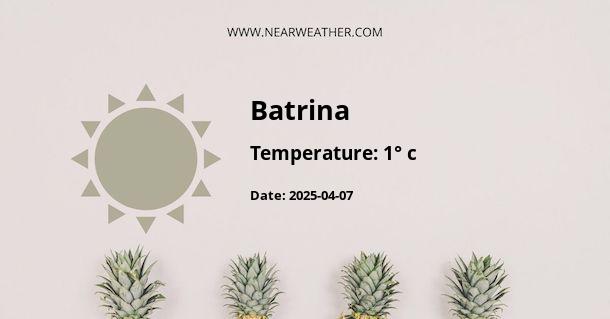Understanding the Climate and Weather of Batrina, HR
Batrina, a charming locale nestled in the heart of Croatia, boasts a diverse climate that reflects the intricate tapestry of its geographical and topographical features. To comprehensively analyze Batrina's climate and weather, we must delve into the regional characteristics that govern its atmospheric conditions, alongside a meticulous examination of the cyclical seasonal variations and meteorological patterns it experiences throughout the year.
Geographical Influence on Batrina's Climate
Batrina’s geographical coordinates place it within a transitional zone, which lends it a climate that is a blend between continental and Mediterranean influences. This confluence is primarily due to its relative proximity to the Adriatic Sea and its positioning on the European landmass.
"Batrina sits at the confluence of continental and Mediterranean climates, engendering a weather pattern characterized by warm, dry summers and cool, wet winters."
Climatological Data Breakdown
To provide an in-depth view of Batrina's climate, let us inspect the climatological data, which serves as a testament to the region's weather-related dynamics:
- Temperature: Batrina typically sees average summer temperatures ranging from 20°C to 30°C (68°F to 86°F), with occasional peaks that can soar even higher. In contrast, the winter season features a colder range, with averages hovering between -2°C to 3°C (28°F to 37°F), and the potential for sub-zero temperatures during nights and cold snaps.
- Precipitation: The area receives moderate quantities of rainfall, averaging around 800-1000 mm (31-39 inches) annually, with the bulk occurring in the cooler months, particularly in autumn and spring.
- Sunshine: A distinguishing characteristic of Batrina is its generous amount of sunlight, which can exceed 2,500 hours per year, ensuring a remarkable degree of natural illumination across the seasons.
- Wind: The locale is subject to diverse wind patterns, with the ‘bura’ being a notable northern wind that brings cold and clear weather, while the ‘jugo’ is a southeasterly wind often associated with damp weather and storms.
Seasonal Outlooks
| Season | Weather Characteristics | Typical Temperature Range | Average Precipitation |
|---|---|---|---|
| Spring | Increasingly warm and mild, with higher rainfall in late spring. | 10°C to 20°C (50°F to 68°F) | 200-250 mm (7.9-9.8 inches) |
| Summer | Hot and dry, with coastal breezes moderating the heat. | 20°C to 30°C (68°F to 86°F) | 50-100 mm (2-4 inches) |
| Autumn | Gradual cooling and increased precipitation, with early autumn remaining warm. | 10°C to 20°C (50°F to 68°F) | 250-300 mm (9.8-11.8 inches) |
| Winter | Cool to cold with snow possible, especially in the hinterlands. | -2°C to 3°C (28°F to 37°F) | 200-250 mm (7.9-9.8 inches) |
Long-term Climatic Trends
As climate change continues to influence weather systems globally, Batrina is not immune to this phenomenon. Studies indicate subtle yet discernible shifts in temperature averages, precipitation patterns, and extreme weather events. These shifts carry potential implications for local agriculture, water resources, and the prevalence of heatwaves and severe storms.
Temperature Trends
Over the past few decades, a gradual warming trend is observable in Batrina, aligning with broader climatic changes impacting the Balkan region. Winters have become milder, with the frequency of sub-zero days decreasing, while summers have become hotter, with a noticeable increase in days surpassing the 30°C (86°F) mark.
Precipitation Patterns
Research suggests alterations in precipitation patterns, with decreased rainfall during summer months and higher intensity events during the spring and autumn. This evolving pattern necessitates adaptive measures in water management and agriculture to sustain local economies and ecosystems.
Extreme Weather Events
The incidence of extreme weather events is on a rise, with increased occurrences of both droughts and heavy downpours leading to flash floods. Authorities and residents alike are advised to bolster their resilience against such sporadic yet significant meteorological phenomena.
Local Meteorological Observations
For real-time information and forecasts, Batrina relies on an integrated network of meteorological stations that diligently record atmospheric data. These stations contribute vital inputs to our understanding and assist in producing accurate and locale-specific weather predictions.
Conclusion and Adaptation Strategies
In conclusion, Batrina's climate is distinctive and multifaceted, with a rich blend of continental and Mediterranean influences that shape its weather throughout the year. The climate is characterized by a pattern of warm and sunny summers, transitional springs and autumns with moderate rainfall, and cool to cold winters that occasionally usher in snow.
As climate change continues to make its impact felt, strategies for adaptation become paramount. This involves improving infrastructure and public services to withstand extreme weather events, conserving natural water resources, and adopting sustainable practices across all sectors.
Those interested in visiting or living in Batrina should remain cognizant of the shifting climate landscape and seek to harmonize with the natural rhythms while contributing positively to the region's environmental sustainability.
Note: All climate data and trends provided in this article are based on historical analysis and current scientific projections. Prudent consideration of the latest climate models and forecasts is advised for those requiring precise weather information.
A - Batrina's Latitude is 45.189442 & Longitude is 17.666389.
A - Weather in Batrina is 19° today.
A - Climate Conditions in Batrina shows few clouds today.
A - Humidity in Batrina is 59% today.
A - Wind speed in Batrina is 13.07 km/h, flowing at 71° wind direction. today.
